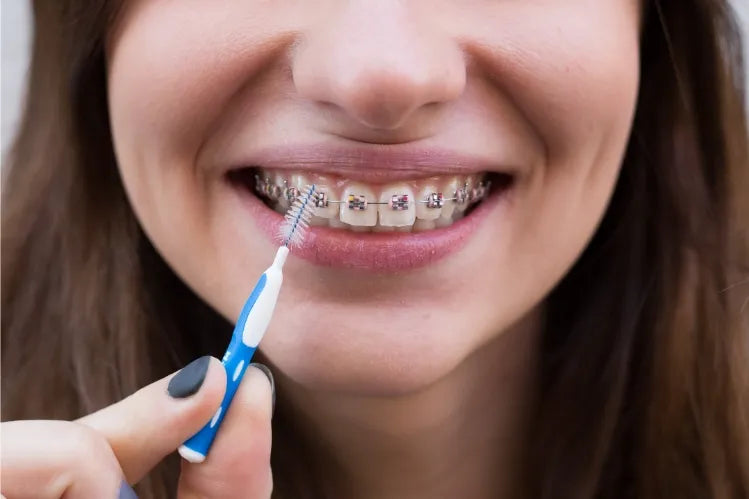
Table of Contents
- Why Oral Hygiene Is Important?
- Why Oral Hygiene Is Crucial with Braces?
- Braces Cleaning Routine: Step-by-Step
- Best Tools for Cleaning Braces
- Tips for Plaque Prevention with Braces
- Foods to Avoid (or Eat with Caution)
- Professional Dental Care During Orthodontic Treatment
- Oral Hygiene Routine for Busy Days
- Final Thoughts: A Healthy Smile Starts with Clean Teeth
- FAQs
Table of Contents
- Why Oral Hygiene Is Important?
- Why Oral Hygiene Is Crucial with Braces?
- Braces Cleaning Routine: Step-by-Step
- Best Tools for Cleaning Braces
- Tips for Plaque Prevention with Braces
- Foods to Avoid (or Eat with Caution)
- Professional Dental Care During Orthodontic Treatment
- Oral Hygiene Routine for Busy Days
- Final Thoughts: A Healthy Smile Starts with Clean Teeth
- FAQs
Braces mark the beginning of your journey to a healthy, beautiful smile. Yet, with them comes some level of responsibility. The most important of them all? Maintain oral hygiene with braces. When brackets and wires are added to your teeth, they create more nooks and crannies for plaque, food particles, and bacteria to hide. Without proper deep cleaning, plaque buildup can lead to gum inflammation, cavities, and delays in your orthodontic treatment.
Whether you wear metal, ceramic, or lingual braces, following an effective cleaning routine ensures your smile will not just be straight, but healthy too. This blog serves as a complete guide to dental care during orthodontic treatment; expert tips on brushing, flossing, plaque prevention, and several of the best oral care tools are included. Now let's get into the candy-horn between braces-and mouth-sparkling clean.
Why Oral Hygiene Is Important
Maintaining good oral hygiene has an essential impact on your overall health. Neglecting it allows bacteria to grow in your mouth, forming plaque, a sticky film that clings to your teeth and gums. If not cleaned properly, this plaque hardens into tartar and leads to:
- Tooth decay
- Gum disease (gingivitis and periodontitis)
- Persistent bad breath (halitosis)
- Infections that could even spread to other parts of your body
Before starting braces, orthodontists check to ensure your mouth is infection-free. That’s because trying to move infected teeth is dangerous. If any infection develops during your treatment, it must be treated first, delaying your orthodontic progress.
Why Oral Hygiene Is Crucial with Braces?
Braces are life-changing, but they make cleaning your mouth more complicated. Wires, brackets, and bands create extra surfaces where food and plaque can hide.
Here’s what can happen if you don’t clean properly with braces:
- Plaque and Tartar Buildup: Braces make it harder to remove plaque, which can harden into tartar and lead to gum disease.
- White Spot Lesions: Decalcified areas can form around brackets if oral care is neglected, leaving permanent white marks.
- Cavities and Bad Breath: Trapped food particles break down, attracting bacteria that produce acids and unpleasant odors.
- Longer Treatment Times: Poor hygiene can lead to complications, forcing your orthodontist to slow or even stop your progress.
If you're looking to skip the hassle of maintaining oral hygiene with braces, clear aligners are a simpler, low-maintenance alternative.
Braces Cleaning Routine: Step-by-Step
Step 1: Rinse
Start by swishing your mouth with lukewarm water. This helps loosen bits of food caught between brackets and prepares your mouth for more effective brushing.
Step 2: Brush Thoroughly

Keeping your teeth clean with braces can be a real challenge. It’s easy for food to get stuck in the brackets and between your teeth, making brushing and flossing even more important than before. To keep plaque from building up, make it a habit to brush after every meal and floss daily.
When brushing, use a soft-bristled toothbrush and hold it at a 45-degree angle to your teeth. Gently move the brush in small circles, paying close attention to the areas above and below your brackets. Braces cause toothbrushes to wear out more quickly, so replace yours as soon as the bristles begin to fray.
Step 3: Plaque

Plaque is a thin, sticky, and nearly invisible layer that constantly forms on your teeth. It’s made up of bacteria and the substances they produce. These bacteria love sugar, and when you eat sugary foods, they feed on it and create acid. If that acid sits on your teeth for too long, it begins to wear down your enamel, leading to cavities and irritated gums.
If plaque isn’t cleaned off regularly, it can even leave behind permanent white marks on your teeth. That’s why it’s important to stay consistent with your cleaning routine. Tools like a Waterpik or an electric toothbrush can make it easier to manage, but they don’t replace professional care. Be sure to keep up dental checkups every six months for a thorough cleaning and peace of mind.
Step 4: Flossing with Braces

Flossing with braces is similar to regular flossing without braces, except that the floss must be threaded under the arch wire and between the teeth. This is where a floss threader (which looks like a large plastic needle) comes in handy.
Here’s how to do it:
- Start by threading the floss under the archwire.
- Once it’s through, remove the threader.
- Gently floss each side of the tooth in that space.
- When you're done, pull the floss out using one hand while letting go with the other.
- Repeat the process for each space between your teeth.
It might take a little longer at first, but with practice, it becomes a smooth part of your daily routine.
Step 5: Braces-Friendly Mouthwash
Choose a fluoride-rich mouthwash to help strengthen your enamel and fight off bacteria.
Skip alcohol-based mouthwashes, though; they can irritate your gums, especially when you’re already dealing with the extra hardware in your mouth.
Best Tools for Cleaning Braces
Having the right tools can make your cleaning routine faster and more effective. Here’s what orthodontists recommend:
Best Toothbrush for Braces
When you’re wearing braces, the right toothbrush can make all the difference.
- Electric toothbrush with an orthodontic head: These are great for getting into hard-to-reach areas and removing plaque more effectively.
- Manual orthodontic toothbrush: Designed with V-shaped bristles that fit around your brackets for a deeper clean.
Tips for Plaque Prevention with Braces
Plaque forms fast and hides easily behind brackets. Here’s how to stop it before it causes real damage:
- Brush after every meal (or rinse with water if you can’t brush).
- Floss every day, no matter how tired you are.
- Avoid sugary snacks and drinks, which feed bacteria.
- Use fluoride toothpaste and rinse to reinforce enamel.
- Chew sugar-free gum to increase saliva, your mouth’s natural defense.
- Use plaque disclosing tablets weekly—they stain leftover plaque to show you where you missed brushing.
Foods to Avoid (or Eat with Caution)
Certain foods can damage your braces or make it harder to clean your teeth. So, if you’ve been wondering if you can eat popcorn with braces , it’s a hard no.
Foods to Avoid
- Sticky candies: caramel, toffee, gummy bears.
- Hard items: nuts, popcorn, ice.
- Sugary drinks: soda, energy drinks.
- Whole fruits: apples or corn on the cob (unless cut into small pieces).
Braces-Friendly Alternatives
- Soft fruits, including bananas and berries.
- Steamed or boiled vegetables.
- Smoothies, soups, and yogurt.
- Soft protein sources like eggs, shredded chicken, tofu.
Professional Dental Care during Orthodontic Treatment
Even with excellent home care, you still need professional checkups. Dentists can spot and fix problems before they escalate.
Visit Your Dentist
- Every 6 months for routine cleanings and exams.
- Every 3–4 months, if you have plaque buildup or gum inflammation.
During these visits:
- Your dentist will remove tartar.
- You’ll get a fluoride treatment if needed.
- They’ll check for cavities and gum inflammation.
Oral Hygiene Routine for Busy Days
If you’re short on time, here’s how to keep up with hygiene:
- Keep a travel kit with a brush, paste, floss picks, and mouthwash.
- Use a water flosser at night for a thorough clean.
- Never skip brushing before bed, plaque builds most overnight.
- Quick daytime clean, then do a full clean before sleeping.
Final Thoughts: A Healthy Smile Starts with Clean Teeth
Braces help straighten your teeth, but proper oral hygiene ensures those teeth are also healthy and beautiful. With the right cleaning tools, good habits, and a consistent routine, you can:
- Prevent decay, white spots, and bad breath.
- Keep treatment on schedule.
- Avoid costly dental problems later.
- Enjoy faster braces pain relief after wire adjustments.
Don’t let all the hard work from your braces go to waste. Commit to caring for your smile every day; it’s worth it.
FAQs
1. Can you do dental hygiene with braces?
Yes! With the right tools and routine, you can maintain excellent oral hygiene during orthodontic treatment.
2. How do you clean your mouth with braces?
Brush after meals, floss daily with threaders or a water flosser, and rinse with fluoride mouthwash. Clean around each bracket thoroughly.
3. Should I use mouthwash every day with braces?
Yes. A braces-friendly, alcohol-free mouthwash helps prevent plaque, strengthens enamel, and keeps your breath fresh.
4. What are the oral hygiene instructions for orthodontic patients?
Brush 2–3 times a day, floss daily, rinse with fluoride mouthwash, avoid sticky or hard foods, and visit your dentist regularly.
Citations:
American Association of Orthodontists. (2021). Brushing and flossing with braces. https://www.aaoinfo.org/treatments/brushing-and-flossing-with-braces/
Guo, R., Zheng, Y., Zhang, Y., Xu, T., & Liu, R. (2018). Effectiveness of oral hygiene education for orthodontic patients using a mobile app: A randomized controlled trial. Journal of Dental Research, 97(2), 186–192. https://doi.org/10.1177/0022034517735290
Al Mulla, A. H., Kharsa, S. A., & Al-Mutairi, M. A. (2019). Impact of fixed orthodontic appliance on oral health-related quality of life among adolescents. Patient Preference and Adherence, 13, 1443–1449. https://doi.org/10.2147/PPA.S210093
Nascimento, D. L., Pithon, M. M., & Nascimento, L. E. (2019). Plaque control in orthodontic patients: A review of the literature. International Journal of Dentistry, 2019, 1–6. https://doi.org/10.1155/2019/4721730







